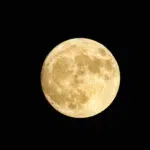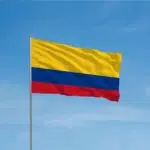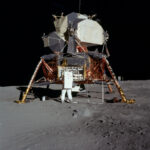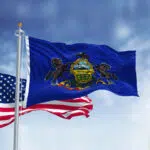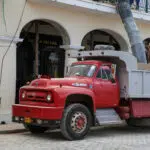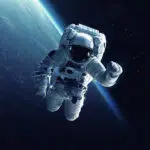When Neil Armstrong stepped down onto the moon’s cratered surface with the words, “That’s one small step for man, one giant leap for mankind, ” every nation on earth seemed to breathe a collective sigh of relief. National Moon Day celebrates not only the historic lunar landing on July 20, 1969, but the day also reminds us of the uphill slog to get the space program literally off the ground. On Moon Day, we remember both the quirky and profound moments in the space race that ended with the Americans being the first to plant their flag on the moon. Stick around— the story is fascinating!
When is Moon Day 2025?
“One small step for man, one giant leap for mankind” is celebrated on National Moon Day on July 20.
History of Moon Day
American astronauts Neil Armstrong, and Edwin ‘Buzz’ Aldrin became the first humans in history to land on the Moon on July 20, 1969. The grand Apollo 11 mission took place eight years after the national goal announcement by President John F. Kennedy to send a man to the moon by the end of the 1960s.
The idea for the mission to send astronauts to the moon started when President Kennedy appealed to a special joint session of Congress in 1961, stating “I believe this nation should commit itself to achieving the goal, before this decade is out, of landing a man on the moon and returning him safely to Earth.”
At the time of Kennedy’s proposal, the United States was still head-to-head with the Soviet Union in advancements in space exploration and, since it was during the time of the Cold War, the proposal was welcomed. The first unmanned Apollo mission was initiated by the National Aeronautics and Space Administration, NASA, after five years of effort and hard work by their international team of engineers and scientists. The first mission served as a testing phase for the structural resilience of the launch spacecraft vehicle.
At 9:32 A.M. on July 16, 1969, the whole world witnessed Apollo 11 take off from Kennedy Space Center with three astronauts on board. Neil Armstrong was the commander of the mission. The spacecraft entered the lunar orbit after three days, on July 19. The lunar module, Eagle, disengaged from the main command module the next day, manned by Armstrong and Aldrin. When Eagle touched the lunar surface, Armstrong radioed his historical message to Mission Control in Houston, Texas: “The Eagle has landed.”
At 10:39 P.M., Armstrong exited the lunar module and made his way down its ladder. His progress was being recorded by a television camera attached to the module, transmitting signals back to Earth, where the world was watching with bated breath.
At 10:56 P.M., Armstrong stepped on the moon’s powdery surface, and spoke his iconic words: “That’s one small step for man, one giant leap for mankind.”
Moon Day timeline
In a historic speech on May 25, President John F. Kennedy signals the start of NASA's Apollo space program as well as his plan to see an American on the Moon by the end of the decade.
For the first time, American TV viewers get to view the Moon's cratered surface from images transmitted by NASA's unmanned probe, Ranger 7.
NASA's Apollo 8 orbits the Moon 10 times as the first manned flight while Americans watch on television.
The world breathlessly watches as Apollo 11's three-man team becomes the first humans to step onto the Moon's surface.
NASA shuts down its Apollo program with a final manned landing — Apollo 17.
No less than five (unmanned) missions are set for between 2020 and 2021, including NASA's Mars 2020 rover.
Traditions
No matter how many years pass, we will always be in awe of the first moon landing in 1969. Landing on the moon was a huge step for mankind and our understanding of the great realm we exist in. Traditions for National Moon Day include watching documentaries and reading books on the Apollo 11 mission, moon watching, and marveling at its glorious luminescence at night.
Space enthusiasts bring out their telescopes to gaze at the moon and they read up on NASA’s upcoming projects and missions. National Moon Day is also prominently celebrated in schools, with the moon being the main topic in classes to educate children on the historical event.
National Moon Day is also especially important for those interested in astrology and astronomy. The positioning of the moon, its effect on Earth, and the planetary moons are greatly discussed and delved into today.
NATIONAL MOON DAY BY NUMBERS
5th – the ranking of our Moon’s size compared to others in our solar system.
14.6 million – the number of square miles of the surface area of the Moon.
30 – the number of Earth-sized planets that could fit between the distance of the Earth and the Moon.
2300 mph – the traveling speed of the Moon orbiting the Earth.
1 inch – the distance the Moon drifts farther from Earth every year.
16.5% – the percentage decrease in a human’s weight on the Moon.
12 – the number of men who have walked on the Moon.
1950s – the period when the U.S. proposed detonating a nuclear bomb on the Moon.
30 seconds – the amount of time in terms of fuel that was left when Neil Armstrong landed on the Moon.
73,476,730,924,573,500,000,000 kg – the mass of the Moon.
Moon Day FAQs
What day is Moon Day?
National Moon Day is on July 20 every year, commemorating Astronaut Neil Armstrong’s landing on the moon.
Why do we celebrate Moon Day?
National Moon Day marks the day in history when man landed on the moon for the first time. On July 20, 1969, Apollo 11 carried two Astronauts to the surface of the moon.
Is the flag still on the moon?
Since the nylon flag was purchased from a government catalog, it was not designed to handle the harsh conditions of space and has somewhat disintegrated.
Moon Day Activities
Visit your local planetarium
If you really want to get up close and personal with the moon, visit your local planetarium. These domed theaters, with massive telescopes, project images of the starry night skies filled with countless spectacular objects we may not be able to see with the naked eye. Visiting the planetarium encourages us to learn about our universe and, more importantly, where we fit in as human beings. Going to a planetarium is also a unique, educational experience where we can learn about astronomy and other related sciences.
Hang out with your local astronomy club
Are you a student lucky enough to have an astronomy club on campus? If so, don't miss the opportunity to sit in on a discussion of the first moon landing or share looks through a telescope. An astronomy club can point you in the direction of upcoming events where other like-minded souls gather to discuss all the celestial bodies in the universe.
Make plans to see the next lunar eclipse
Get ready for a nighttime show! Put a reminder in your calendar about the next lunar eclipse. Make plans to bring a picnic basket filled with goodies, a blanket, binoculars, or a telescope and head out to your favorite viewing spot. Enjoy one of nature's most dramatic shows!
5 Spacey Tidbits About America's First Lunar Landing
Three African-American women got us there
Mathematician Katherine Johnson, along with two other black women, were instrumental in calculating NASA's routes to the moon for its first lunar landing. Director Theodore Melfi and writer Allison Schroeder finally told their story in the 2016 film Hidden Figures.
Wright Brothers along for the ride
Armstrong felt it was important to show how aviation had progressed which is why he carried a small piece of wood from one of the Wright Brothers' planes.
High drama
By the time it landed, the Lunar Module barely had any fuel left.
High ratings
Over 600 million people around the world watched the live lunar landing, eclipsing all previous TV ratings records.
Washington prepared for the worst
President Nixon had an alternate speech ready in case the mission failed.
Why We Love Moon Day
The moon exploded into existence
Call it the 'Big Whack'! The moon formed when a giant Mars-sized object hit earth 4.6 billion years ago and a cloud of vaporized rock spun into orbit encircling the earth. Once the cloud cooled, it transformed into smaller chunks that combined together, creating our moon.
The moon is not as big as you think
Although the moon is the brightest object we see in the night sky, its diameter is about one-quarter the size of Earth but with less gravity. For example, if you weigh 150 pounds, you'd only weigh 25 pounds on the moon. Also, our moon is not the largest one in the galaxy. The moon is only about the fifth largest one in our immediate solar system.
The moon shakes with quakes
The moon has earthquakes (or in this case, moonquakes) that sometimes form cracks where gasses escape. What a strange landscape for the Apollo crew to walk on, don't you think?
Moon Day dates
| Year | Date | Day |
|---|---|---|
| 2025 | July 20 | Sunday |
| 2026 | July 20 | Monday |
| 2027 | July 20 | Tuesday |
| 2028 | July 20 | Thursday |
| 2029 | July 20 | Friday |


